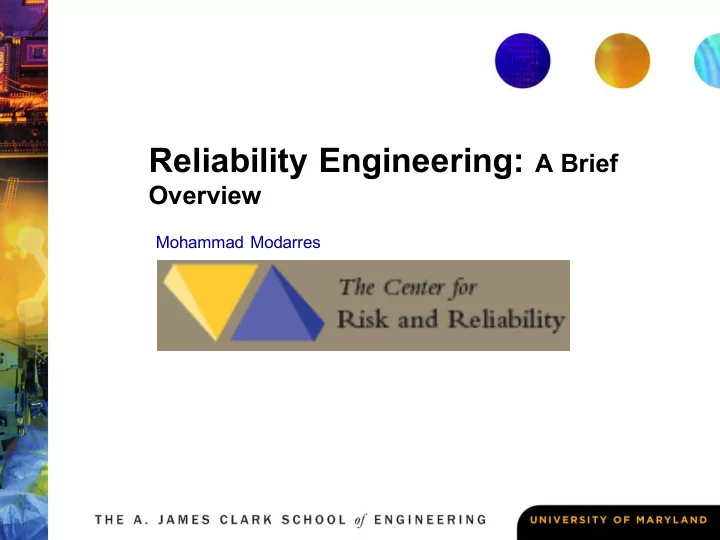

Reliability Engineering: A Brief Overview Mohammad Modarres
Reliability Engineering Overview • Reliability engineering measures and improves resistance to failure over time, estimates expended life, and predicts time-to-failure • What reliability engineers do? – Study ways to prevent failures • Robust Design • Monitor and correct degradation and damage – Develop and use models to assess damage, degradation, and aging – Predict the time-of-failure (e.g., MTTF, MTBF) – Assess complex system reliability – Develop prognosis and health assessment (PHM) methods
Evolution of Reliability Engineering • Two Overlapping Themes for Modeling Life and Performance of Items Have Emerged: 1. Data / Evidence Driven View: • Statistical • Probabilistic 2. Physics Driven View: • Empirical: Physics of Failure • Physical Laws • Examples of Areas of Applications – Design (Assuring Reliability, Testing, Safety, Human- Software-Machine, Warranty) – Operation (Repair, Maintenance, Risks, Obsolescence, Root Cause Evaluations)
Data and Physics Views 1. Data View: Post WWII Initiatives due to unreliability of electronics and fatigue issues--asserts that historical failure data or reliability test data represent the truth • Predicted reliability from historical data exists as the likelihood of no failure 𝑆 𝑢; 𝜄 = Pr 𝑈𝑗𝑛𝑓 − 𝑢𝑝 − 𝑔𝑏𝑗𝑚𝑣𝑠𝑓 ≥ 𝑒𝑓𝑡𝑗𝑠𝑓𝑒 𝑚𝑗𝑔𝑓 𝑢𝑗𝑛𝑓 • Reliability of systems composed of multiple items : 𝑆 "#" = 𝑆 & ;𝑗 = 1, …𝑂 – Logical connections of the components (fault trees, etc.) – Reliability block diagrams • Common Assumptions – Maintenance and repair contribute to the renewal – Degradation can be measured by the hazard rate. 2. Physics View: Failures occur due to known underlying failure mechanisms: • Accumulate damage until exceeds endurance (i.e., resistance to damage) • Performance decline which until a minimum requirement reached • Applied stresses (load) exceeds strength (capacity) to resist the applied stress
Thank you for your attention!
Recommend
More recommend